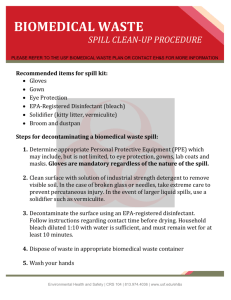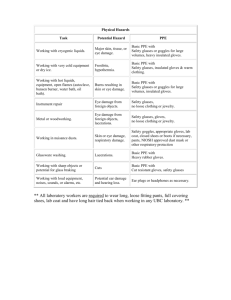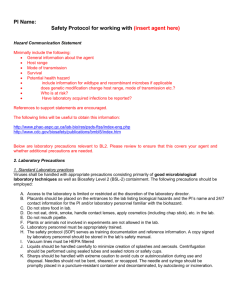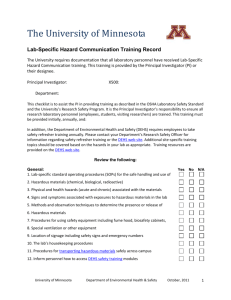Biosafety Manual template - University of Alaska Fairbanks
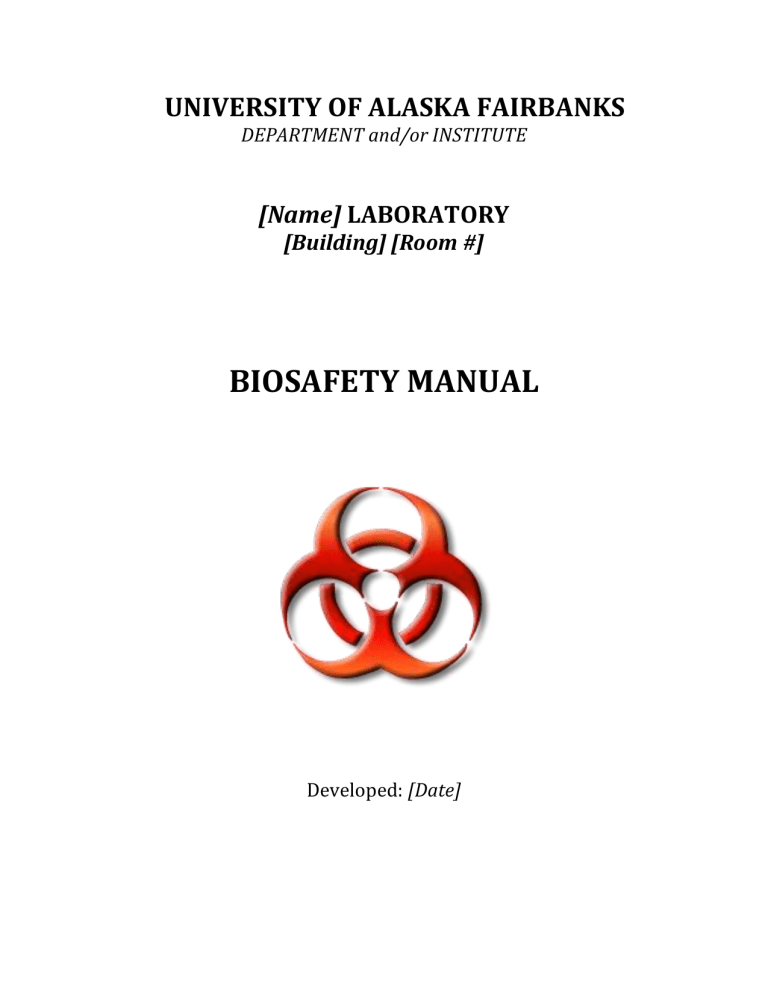
UNIVERSITY OF ALASKA FAIRBANKS
DEPARTMENT and/or INSTITUTE
[Name] LABORATORY
[Building] [Room #]
BIOSAFETY MANUAL
Developed: [Date]
[NAME] Laboratory
Biosafety Manual
TABLE OF CONTENTS
Administrative section
Biological Agent Information
Security Provisions
Exposure Risk Assessment
Training
Laboratory Safety Facilities
Required Personal Protective Equipment (PPE)
Daily Lab Cleaning Activities
Spill Response
Exposures
Standard Operating Procedures
Signature/Acknowledgment Page
Appendices
ADMINISTRATIVE SECTION
Lab Personnel:
Principle Investigator:
[Name]
[Title]
Phone: insert here
Email: insert here
[List additional personnel and contact information here]
Building and Lab Room Number:
Date IBC protocol prepared:
Date IBC protocol last modified:
______________________________________________________
______________________________________________________
______________________________________________________
IBC registration number(s):
Project title(s):
Date approved:
______________________________________________________
____________________________________________________________________
Document number: ____________________________________________________________________
____________________________________________________________________
IACUC approval number(s), if applicable: __________________________________
Assigned Biosafety Level: __________
Bloodborne Pathogens Exposure Control Plan required? _________
BIOLOGICAL AGENT INFORMATION
Biological agents in use:
List all agents, including bacterial, viral, animal, and fungal agents
Location of agents:
Stock storage:
Describe where all stocks will be stored (location, room, building)
Working stock storage:
Describe where all stocks will be stored (location, room, building)
Laboratory working areas:
Describe where work will occur in the lab
SECURITY PROVISIONS
Access to the lab is controlled by [describe locking and access mechanism—e.g., key, card swipe]
[Describe other security provisions—for example, “Freezers where stocks are stored will be kept locked. Keys are available only to specified personnel.”, etc.]
EXPOSURE RISK ASSESSMENT
Agents:
[Describe any health risks associated with each agent used in this lab, including route(s) of exposure and susceptible populations (e.g., immunocompromised individuals, pregnant women, fetus).
Antibiotic resistance traits of agents in use:
List for each agent that possesses or will ultimately possess any antibiotic resistance traits
Symptoms of exposure:
List for each agent in use
Hazards associated with tasks performed in this lab:
Potential hazards include: [delete any that do not apply; add others as needed]
A.
Aerosol hazards:
Some procedures can generate aerosols, which pose an inhalation hazard if the agent in use is a respiratory pathogen or if exposure may occur via mucous membranes. Such procedures include: i.
Centrifugation ii.
Using the vortex, sonicator, or blender iii.
Pipetting to resuspend cells, mix contents of tubes, etc. iv.
Aspirating cell culture media v.
Spills and splashes
B.
Injection hazards: a.
Use of needles and syringes b.
Use of razor blades or scalpels c.
Microscope slides and cover slips d.
Broken glass
Measures that will be taken to mitigate these exposure hazards:
To minimize the risk of exposure to biological agents and contamination of lab equipment, the following measures will be taken: [delete any that do not apply; add others as needed]
1.
Capping tubes during centrifugation and vortexing
2.
Using safety buckets or sealed rotors in centrifuges
3.
Opening the rotor or safety buckets only in a biological safety cabinet
4.
Opening centrifuge tubes only in a biological safety cabinet
5.
Aspirating cell culture media in a biological safety cabinet
6.
Using an inline HEPA filter on the vacuum line in addition to a trap
7.
Wearing an N-95 filtering facepiece (face mask) when performing procedures outside a biological safety cabinet
8.
Utilizing a microincinerator or disposable loops instead of a Bunsen burner
To minimize exposure to the biological agents used in the lab, all lab personnel will strictly adhere to lab Standard Operating Procedures included in this Biosafety manual.
TRAINING
All employees must receive the following training:
1.
UAF Laboratory Safety (from EHSRM)
2.
UAF Hazardous Materials Management (from EHSRM)
3.
UAF Autoclave Safety (in-person; from EHSRM or IAB)
4.
Biological Safety Cabinet (available through Blackboard)
5.
Training on specific procedures conducted in this lab (from the PI)
6.
A review of this Biosafety Manual (from PI)
7.
Hazardous Materials Transportation training (if shipping biological materials; inperson from EHSRM)
LABORATORY SAFETY FEATURES
The following safety features are available in the lab [delete any non-applicable, and add any
additional that apply to your lab]:
1.
A sink for hand washing
2.
An eyewash station
3.
An emergency shower
4.
Impervious, chemical-resistant bench tops
5.
Biosafety cabinet
6.
HEPA filters on all vacuum lines (prevents contamination of vacuum lines)
REQUIRED PERSONAL PROTECTIVE EQUIPMENT (PPE)
PPE is provided at no cost to employees. The lab is responsible for maintaining the inventory of PPE, purchasing, and storing PPE.
Training in the use of required PPE will be provided by the PI and/or knowledgeable technician. PPE is located in the lab and non-disposable PPE shall not be taken home to be laundered.
All employees using PPE shall observe the following precautions:
1.
Wash hands immediately or as soon as possible after removing gloves and/or other
PPE.
2.
Remove PPE after it becomes contaminated and before leaving the work area.
3.
Dispose of used PPE properly.
4.
Wear appropriate gloves when it is reasonably anticipated that there may be hand contact with blood or biohazardous materials, or when handling or touching contaminated items or surfaces.
5.
Replace disposable gloves if torn or punctured, or if their ability to function as a barrier is compromised.
6.
Never wash or decontaminate disposable gloves for reuse.
7.
Non-disposable gloves may be decontaminated for reuse if their integrity is not compromised. Discard gloves if they show signs of cracking, peeling, tearing, punctures, or deterioration.
8.
Wear appropriate face and eye protection when there is a risk of splashes, sprays or splatters that may result in contact with the eyes, nose, or mouth.
9.
Garments that are contaminated with biological materials must be removed immediately or as soon as possible, and done in such a way as to avoid contact with the outer surface.
LAUNDRY
Lab personnel will wear protective gloves and other appropriate PPE for occupational exposure during handling or sorting of soiled or contaminated lab coats.
Lab coats are placed into a 5 gallon bucket and 10% bleach is added to the bucket to completely saturate and cover the lab coat(s). The bucket is covered and allowed to stand for 20 minutes prior to transportation to the [list location here] laundry facility, where they are immediately laundered. [Note: this procedure may be rewritten to describe what
happens in your facility.]
To launder contaminated lab coats:
1.
Carefully drain any bleach solution from buckets (if there are any) into the washing machine.
2.
Add soap and begin filling the washing machine with water.
3.
As it is filling, carefully add the lab coats, beginning with any that have been bleached prior to laundering and then adding others.
DAILY LAB CLEANING ACTIVITIES
All work surfaces will be cleaned daily using [list effective disinfectants here, their storage location, the dilution that is used, and if they are rotated to reduce the development of
resistance by the organism or agent].
Disinfectant Storage location Dilution used e.g. Bleach Under the sink 1 pt bleach: 10 pt water
Shelf life
Make fresh daily; keep out of sunlight
Rotated?
No
Equipment such as centrifuges, pipetmen, and test tube racks will be wiped with [list
disinfectant here] daily.
[Describe any other cleaning activities that should be performed, and the frequency with which they should be performed.]
SPILL RESPONSE
Effective disinfectants/neutralizing agents:
List each one and describe storage location here
1.
Spills:
Small spills
There is a risk of spills with the procedures performed in the lab. If a small spill or splash occurs, the following procedure will be used to clean up the area:
1.
Carefully place a paper towel over the spill to help absorb it.
2.
Wearing personal protective equipment (PPE; gloves, splash goggles, lab coat), carefully cover the spill area with 10% bleach or 70% ethanol, working from the outside edges of the spill toward the center.
3.
Let the material sit for 15 minutes, wetting with additional bleach or ethanol as needed to keep the towels wet with disinfectant.
4.
Continuing to wear PPE, carefully pick up any broken glass with tongs or a dustpan and place in a bucket of 10% bleach. a.
Leave broken glass in the bleach for a minimum of 20 minutes. b.
Drain and rinse with regular water. c.
Discard broken glass into broken glass disposal box in lab.
5.
Carefully wipe spill area with additional paper towels. Place paper towels in bucket of 10% bleach.
6.
Once floor is dry, spray area with 10% bleach or 70% ethanol. Let sit for a minimum of 15 minutes, spraying with additional bleach or ethanol as necessary to keep the floor wetted.
7.
After 15 minutes, wipe area with clean paper towels. Discard paper towels into bucket of 10% bleach.
8.
After paper towels have been in the 10% bleach for at least 20 minutes, they may be drained and wrung out and then discarded into the regular trash.
NOTE: DO NOT autoclave items that have been bleached. This can generate toxic chlorine gas in the autoclave, damaging the autoclave and posing a health risk to those near the autoclave.
Large spills
If a large spill occurs or if material is spilled from a significant height (e.g., from bench level to floor):
1.
Employees must evacuate the lab immediately, and remain outside the area for 30 minutes. This will allow aerosols to settle.
2.
Call the UAF Biosafety Officer (474-6771) or EHSRM Hazmat (474-5617) to notify them of the spill and to request assistance if needed.
3.
After 30 minutes, don PPE and clean up the spill following the procedure described above for small spills.
EXPOSURES
A UAF Report of Accident/Injury must be filled out in the event of any laboratory injury, and EHSRM must be notified as soon as possible. The industrial hygienist can assist with arrangements for post-exposure prophylaxis, vaccinations, and/or boosters through the
UAF Occupational Health Program (474-6771).
First aid procedures to follow in the event of an injury that results in an exposure:
Describe here
STANDARD OPERATING PROCEDURES
Insert all SOPs here for procedures performed in the lab. Pay close attention to any PPE requirements or work practices that must be used (e.g., use biological safety cabinet; wear face shield).
SIGNATURE/ACKNOWLEDGMENT PAGE
The following employees have completed training on this Biosafety Manual and the
Standard Operating Procedures performed in the [insert PI name here] lab.
Employee Name
(please print clearly) Initials Date Position/Title
APPENDICES
May include items such as:
The Biosafety Level signage for the lab, indicating the agent(s) in use, the disease(s) caused by the agent(s), any requirements for entry into the room, the name of the PI, and emergency contact information for the PI
the Safety Data Sheet for the organism (available from Health Canada or from UAF’s
MSDS Online subscription)
SDS for disinfectants used in the lab
A copy of the Biosafety in Microbiological and Biomedical Laboratories, 5th Edition, or applicable parts; available at http://www.cdc.gov/biosafety/publications/bmbl5/.
A copy of Principles of Good Microbiological Practices (from the American Biological
Safety Association)
